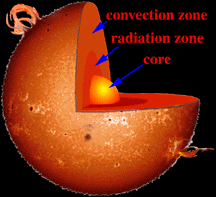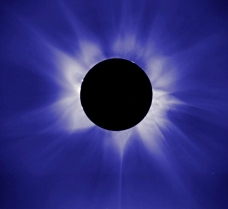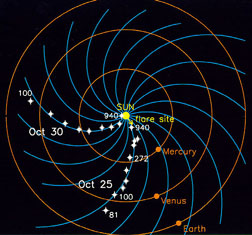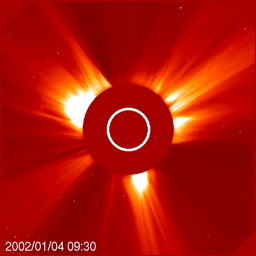Schematic view of the inner structure of the Sun
Click on image for full size and a more detailed image of the interior of the Sun
NASA
The Solar Interior
To understand how our Sun works, it helps to imagine that the inside
of the Sun is made up of different layers, one inside the other.
The core, or the center of the Sun, is the region where the energy of the Sun is produced. Even on Earth we know
that the Sun produces energy because we see sunlight and we feel hot on a summer day.
The Sun's energy, which is produced in the core, travels outwards.
The energy travels first through the
radiative zone, where particles of light (photons) carry the energy. It
actually takes millions of years for a photon to move to the next layer,
the convection zone.
At the
convection zone, energy is transferred more rapidly. This time it is
the motion of the gases in the Sun that transfers the energy outwards.
The gas at this layer mixes and bubbles, like the motion in a pot of boiling
water.This bubbling effect is seen on
the surface of the Sun,
and is called granulation.
We can't see inside the Sun. So scientists
use other diagnostics. These
diagnostics help us know what is inside the Sun.
You might also be interested in:

The convection zone is farther away from the core than the the radiative zone. At this point turbulent convective motions occur, similar to a pot of boiling water. The overturning (bubbling) motions inside
...more
The Sun releases energy. The processes that make this energy take place in the center of the Sun. We can't see past the surface of the Sun. But scientists use indirect ways (diagnostics) to figure out
...more
The Sun's radiative zone is the section of the solar interior between the innermost core and the outer convective zone. In the radiative zone, energy generated by nuclear fusion in the core moves outward
...more
Thermal physics is a field of science that deals with heat and temperature. When we study topics like global warming, the Earth's solid and liquid cores, and the way in which energy flows from the center
...more
Scientists at the High Altitude Observatory (HAO) try to understand the changes we see in the Sun over time. They also study how these changes affect the atmosphere of the Earth. There are four main areas
...more
What are the "parts" of the Sun? The photosphere is the visible "surface" of the Sun. The three regions of the solar interior are the core, the radiative zone, and the uppermost convective
...more
IMF stands for Interplanetary Magnetic Field. It is another name for the Sun's magnetic field. The Sun's magnetic field is huge! It goes beyond any of the planets. The Sun's magnetic field got its name
...more
"Without warning, the relatively calm solar atmosphere can be torn asunder by sudden outbursts of a scale unknown on Earth. Catastrophic events of incredible energy...stretch up to halfway across the visible
...more












